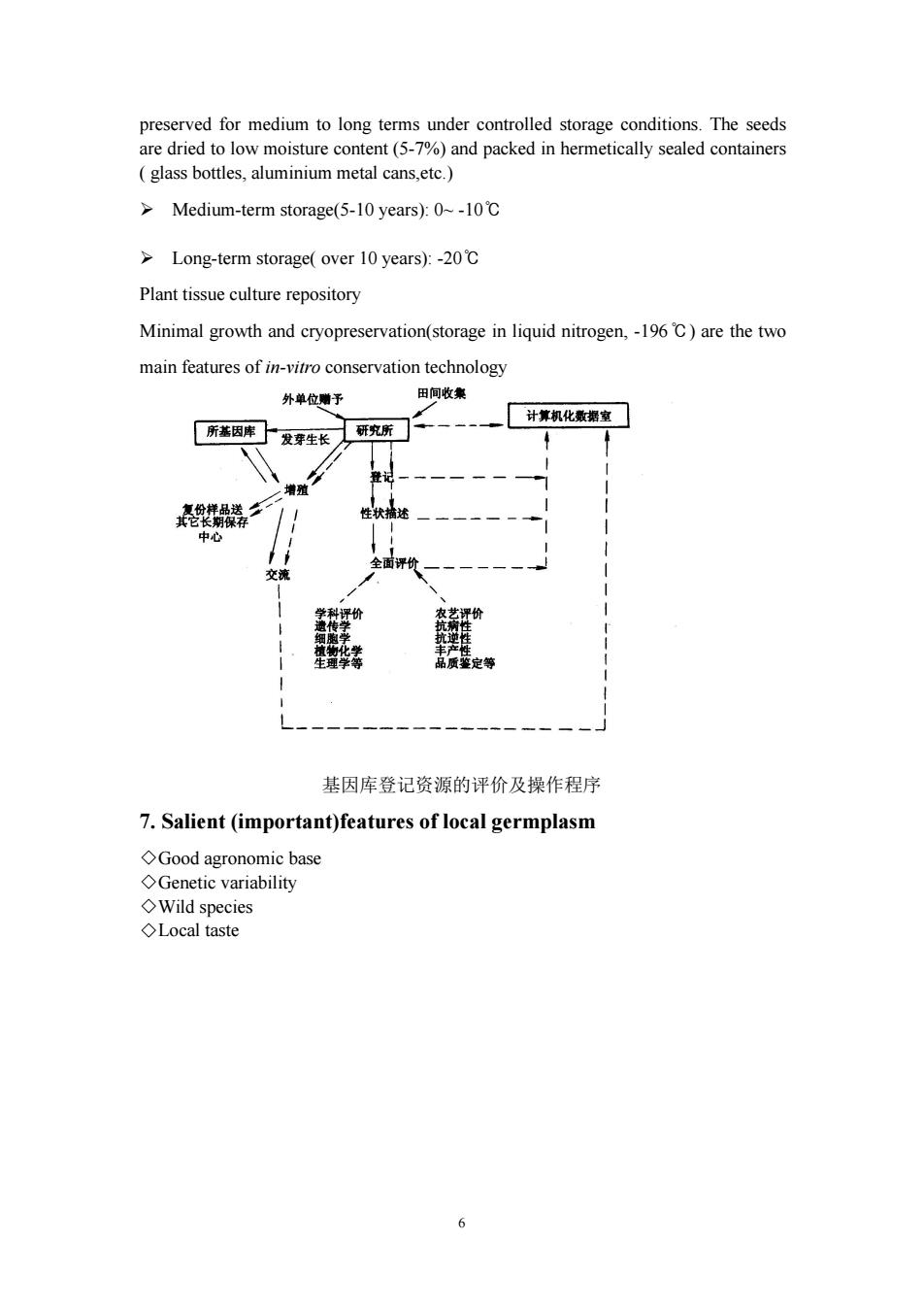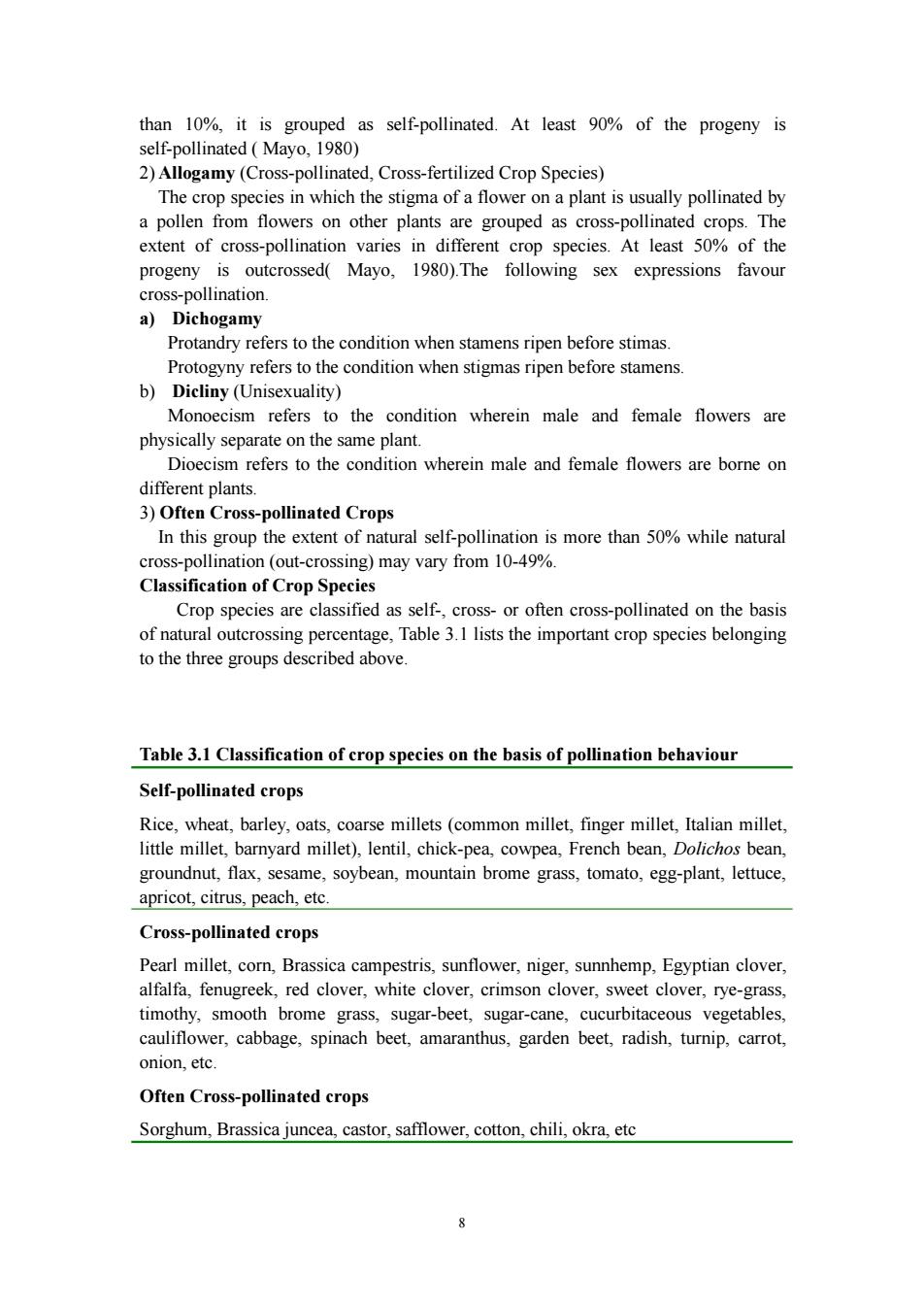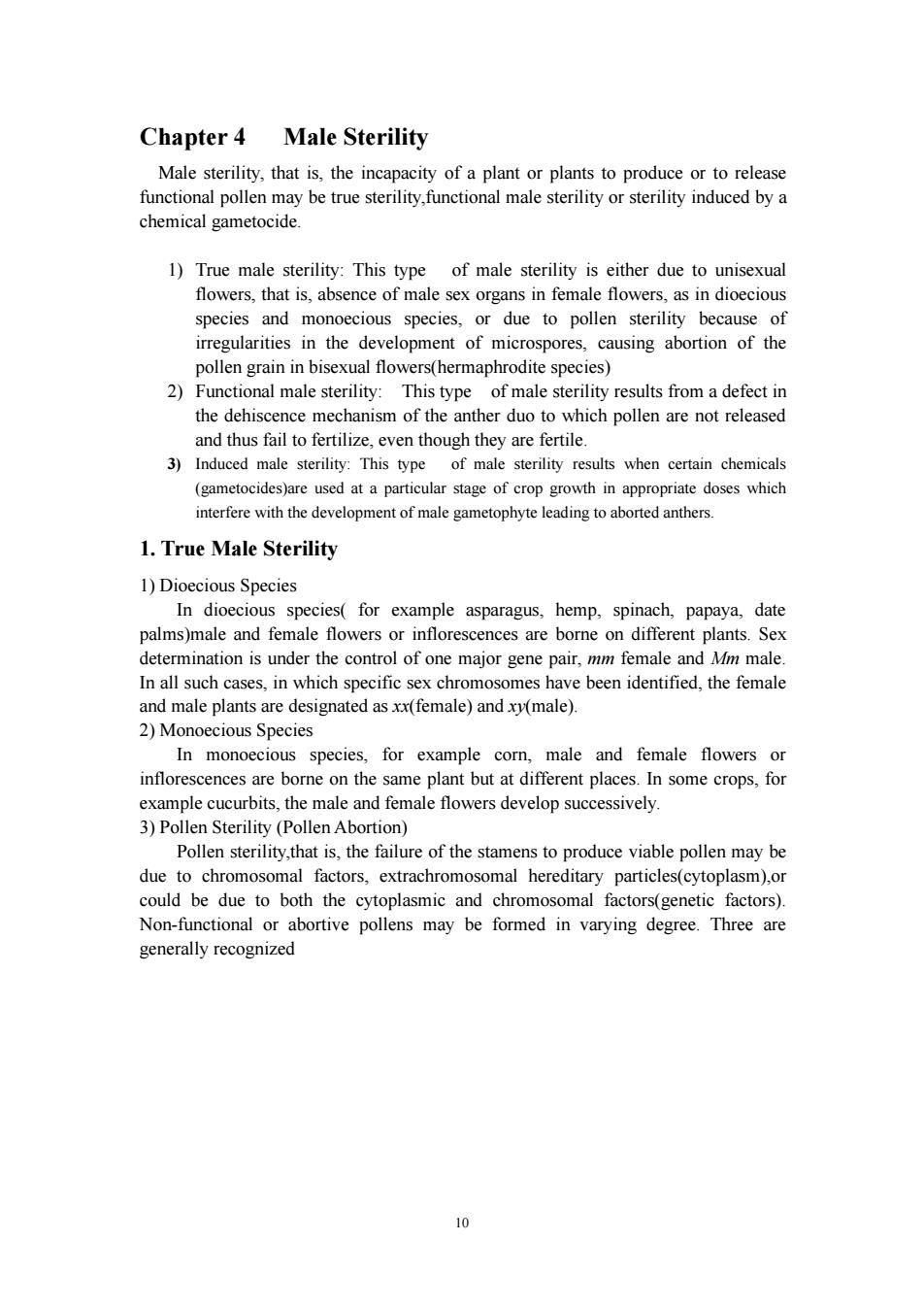
preserved for medium to long terms under controlled storage conditions.The seeds are dried to low moisture content(5-7%)and packed in hermetically sealed containers glass bottles,aluminium metal cans,etc.) Medium-term storage(5-10 years):0~-10C >Long-term storage(over 10 years):-20C Plant tissue culture repository Minimal growth and cryopreservation(storage in liquid nitrogen,-196C)are the two main features of in-vitro conservation technology 外单位赠予 田间收集 计算机化数据室 所基因库 厂发芽生长 研究所 增殖 中心 交流 农艺评价 品质 定等 基因库登记资源的评价及操作程序 7.Salient (important)features of local germplasm ◇Good agronomic base ◇Genetic variability ◇Wild species ◇Local taste
6 preserved for medium to long terms under controlled storage conditions. The seeds are dried to low moisture content (5-7%) and packed in hermetically sealed containers ( glass bottles, aluminium metal cans,etc.) Medium-term storage(5-10 years): 0~ -10℃ Long-term storage( over 10 years): -20℃ Plant tissue culture repository Minimal growth and cryopreservation(storage in liquid nitrogen, -196℃) are the two main features of in-vitro conservation technology 基因库登记资源的评价及操作程序 7. Salient (important)features of local germplasm ◇Good agronomic base ◇Genetic variability ◇Wild species ◇Local taste

Chapter 3 Reproductive System A good insight into reproductive systems of crop species is necessary for a plant breeder for the following reasons. Plant breeding methodology differs for the most part according to the system of reproduction of a crop species.To determine the most appropriate methodology for a crop species precise knowledge of its reproductive system is therefore essential. A plant breeder is required to make artificial hybridization for genetic studies to elicit information regarding inheritance of specific traits and interspecies relationships and for transferring desired characters from one breeding material to another.Precise knowledge of floral structure,floral biology,sex expression,mode of natural pollination and extent of natural outcrossing,etc.for the crop species with which a plant breeder is working is thus essential. Precise knowledge of reproductive behavior is also needed to control pollination to avoid unwanted hybrids (outcrosses)both in breeding nurseries and in pure seed production for commercial purposes,and in the development of hybrid varieties and hybrid seed production. The possible range of reproductive systems in crop species is rather large.The reproductive systems of interest to a plant breeder are discussed below. 1.Sexual Reproduction The normal sexual life cycle of a plant is shown in Fig.4.1. Sporophyte-meiosis-Spore-Gametophyte-fertilization-Zygote-Seed with embryo 1)Autogamy (Self-pollinated,Self-fertilized Crop Species) Crop species in which the pollen of a flower usually pollinates the stigma of the same flower are grouped as self-pollinated crops.The extent of self-pollination varies in different crop species.The following sex expressions favour self-pollination. a))Cleistogamy Refer to the condition wherein pollination takes place in unopened flowers,thus ensuring total self-pollination. b)Chasmogamy Refer to the condition wherein the flower opens only after pollination has taken place.Since the flower opens some outcrossing may take place,though the extent is usually very low. c)Floral Structure In many species,although pollination usually takes place after the flower opens, self-pollination is ensured by the floral structure.The following floral structures favour self-pollination: 1)Stigma may be closely surrounded by anthers,e.g.tomato,eggplant 2)Stamens and stigma are hidden by other floral organs,e.g.legumes. 3)Stigma becomes receptive and elongates through the staminal column,which ensures predominant self-pollination. As a rule,when the extent of natural cross-pollination in a crop species is less
7 Chapter 3 Reproductive System A good insight into reproductive systems of crop species is necessary for a plant breeder for the following reasons. ◇Plant breeding methodology differs for the most part according to the system of reproduction of a crop species. To determine the most appropriate methodology for a crop species precise knowledge of its reproductive system is therefore essential. ◇A plant breeder is required to make artificial hybridization for genetic studies to elicit information regarding inheritance of specific traits and interspecies relationships and for transferring desired characters from one breeding material to another. Precise knowledge of floral structure, floral biology, sex expression, mode of natural pollination and extent of natural outcrossing, etc. for the crop species with which a plant breeder is working is thus essential. ◇Precise knowledge of reproductive behavior is also needed to control pollination to avoid unwanted hybrids (outcrosses) both in breeding nurseries and in pure seed production for commercial purposes, and in the development of hybrid varieties and hybrid seed production. The possible range of reproductive systems in crop species is rather large. The reproductive systems of interest to a plant breeder are discussed below. 1. Sexual Reproduction The normal sexual life cycle of a plant is shown in Fig.4.1. Sporophyte—meiosis—Spore—Gametophyte—fertilization—Zygote—Seed with embryo 1) Autogamy (Self-pollinated, Self-fertilized Crop Species) Crop species in which the pollen of a flower usually pollinates the stigma of the same flower are grouped as self-pollinated crops. The extent of self-pollination varies in different crop species. The following sex expressions favour self-pollination. a) Cleistogamy Refer to the condition wherein pollination takes place in unopened flowers, thus ensuring total self-pollination. b) Chasmogamy Refer to the condition wherein the flower opens only after pollination has taken place. Since the flower opens some outcrossing may take place,though the extent is usually very low. c) Floral Structure In many species, although pollination usually takes place after the flower opens, self-pollination is ensured by the floral structure. The following floral structures favour self-pollination: 1) Stigma may be closely surrounded by anthers,e.g. tomato, eggplant. 2)Stamens and stigma are hidden by other floral organs,e.g. legumes. 3)Stigma becomes receptive and elongates through the staminal column, which ensures predominant self-pollination. As a rule, when the extent of natural cross-pollination in a crop species is less

than 10%,it is grouped as self-pollinated.At least 90%of the progeny is self-pollinated(Mayo,1980) 2)Allogamy(Cross-pollinated,Cross-fertilized Crop Species) The crop species in which the stigma of a flower on a plant is usually pollinated by a pollen from flowers on other plants are grouped as cross-pollinated crops.The extent of cross-pollination varies in different crop species.At least 50%of the progeny is outcrossed(Mayo,1980).The following sex expressions favour cross-pollination. a)Dichogamy Protandry refers to the condition when stamens ripen before stimas. Protogyny refers to the condition when stigmas ripen before stamens. b)Dicliny (Unisexuality) Monoecism refers to the condition wherein male and female flowers are physically separate on the same plant. Dioecism refers to the condition wherein male and female flowers are borne on different plants. 3)Often Cross-pollinated Crops In this group the extent of natural self-pollination is more than 50%while natural cross-pollination (out-crossing)may vary from 10-49%. Classification of Crop Species Crop species are classified as self-,cross-or often cross-pollinated on the basis of natural outcrossing percentage,Table 3.1 lists the important crop species belonging to the three groups described above. Table 3.1 Classification of crop species on the basis of pollination behaviour Self-pollinated crops Rice,wheat,barley,oats,coarse millets (common millet,finger millet,Italian millet, little millet,barnyard millet),lentil,chick-pea,cowpea,French bean,Dolichos bean, groundnut,flax,sesame,soybean,mountain brome grass,tomato,egg-plant,lettuce, apricot,citrus,peach,etc. Cross-pollinated crops Pearl millet,corn,Brassica campestris,sunflower,niger,sunnhemp,Egyptian clover, alfalfa,fenugreek,red clover,white clover,crimson clover,sweet clover,rye-grass, timothy,smooth brome grass,sugar-beet,sugar-cane,cucurbitaceous vegetables, cauliflower,cabbage,spinach beet,amaranthus,garden beet,radish,turnip,carrot, onion,etc. Often Cross-pollinated crops Sorghum,Brassica juncea,castor,safflower,cotton,chili,okra,etc
8 than 10%, it is grouped as self-pollinated. At least 90% of the progeny is self-pollinated ( Mayo, 1980) 2) Allogamy (Cross-pollinated, Cross-fertilized Crop Species) The crop species in which the stigma of a flower on a plant is usually pollinated by a pollen from flowers on other plants are grouped as cross-pollinated crops. The extent of cross-pollination varies in different crop species. At least 50% of the progeny is outcrossed( Mayo, 1980).The following sex expressions favour cross-pollination. a) Dichogamy Protandry refers to the condition when stamens ripen before stimas. Protogyny refers to the condition when stigmas ripen before stamens. b) Dicliny (Unisexuality) Monoecism refers to the condition wherein male and female flowers are physically separate on the same plant. Dioecism refers to the condition wherein male and female flowers are borne on different plants. 3) Often Cross-pollinated Crops In this group the extent of natural self-pollination is more than 50% while natural cross-pollination (out-crossing) may vary from 10-49%. Classification of Crop Species Crop species are classified as self-, cross- or often cross-pollinated on the basis of natural outcrossing percentage, Table 3.1 lists the important crop species belonging to the three groups described above. Table 3.1 Classification of crop species on the basis of pollination behaviour Self-pollinated crops Rice, wheat, barley, oats, coarse millets (common millet, finger millet, Italian millet, little millet, barnyard millet), lentil, chick-pea, cowpea, French bean, Dolichos bean, groundnut, flax, sesame, soybean, mountain brome grass, tomato, egg-plant, lettuce, apricot, citrus, peach, etc. Cross-pollinated crops Pearl millet, corn, Brassica campestris, sunflower, niger, sunnhemp, Egyptian clover, alfalfa, fenugreek, red clover, white clover, crimson clover, sweet clover, rye-grass, timothy, smooth brome grass, sugar-beet, sugar-cane, cucurbitaceous vegetables, cauliflower, cabbage, spinach beet, amaranthus, garden beet, radish, turnip, carrot, onion, etc. Often Cross-pollinated crops Sorghum, Brassica juncea, castor, safflower, cotton, chili, okra, etc

Determination of Model of Sexual Reproduction The mode of sexual reproduction,i.e.,whether a crop is self-pollinated or cross-pollinated is reasonably well known for agricultural species.However,if it is not known in respect of a new crop species it can be easily determined.The various steps involved in determination are: 1)Examination of floral structure:The presence of unisexual flowers,dichogamy or other mechanisms(conditions)would indicate the likelihood of cross-pollination. 2)Seedset in isolated single plants:Grow single plants in isolation and observe whether seeds are produced or not. a)If no seed are produced,this is a certain indication that the crop species in question is cross-pollinated. b)If seeds are produced,then it is necessary to grow the selfed seed.Self-pollinated crops do not show inbreeding depression or adverse effects.On the contrary,in cross-pollinated crops the adverse effect of inbreeding is noticeable to varying degrees. 3)Extent of natural outcrossing:This is determined by interplanting with strains carrying a recessive marker gene.Seeda are harvested from the recessive type and the amount of natural outcrossing is calculated from the proportion of recessive and dominant progeny. 2.Asexual Reproduction Asexual reproduction means reproduction through vegetative parts of the plant,such as,buds(roses),bulbs(tulips),tubers(potato),stems(sugar-cane),or other parts,that are utilized to produce new individuals.In addition to these,there are types of asexual reproduction induced under the term apomixes which we shall detail below. Apomixis Apomixes is the substitution of a sexual process with an asexual process.All forms of asexual reproduction in higher plants that replace or act as substitutes for sexual reproduction are known as apomixes. Types of Apomixis 1.Agamospermy In this type of apomixes sexual organs or related parts take part but the seeds are formed asexually without the union of male and female gametes.This is due to modification of the normal meiotic and fertilization processes.Agamospermy is divided into three main groups. a)Gametophytic apomixes b)Adventitious embryony(adventive embryony,sporophytic embryony) c)Non-recurrent apomixes 2.Vegetative apomixes 9
9 Determination of Model of Sexual Reproduction The mode of sexual reproduction, i.e., whether a crop is self-pollinated or cross-pollinated is reasonably well known for agricultural species. However, if it is not known in respect of a new crop species it can be easily determined. The various steps involved in determination are: 1) Examination of floral structure: The presence of unisexual flowers, dichogamy or other mechanisms (conditions) would indicate the likelihood of cross-pollination. 2) Seedset in isolated single plants: Grow single plants in isolation and observe whether seeds are produced or not. a) If no seed are produced, this is a certain indication that the crop species in question is cross-pollinated. b) If seeds are produced, then it is necessary to grow the selfed seed. Self-pollinated crops do not show inbreeding depression or adverse effects. On the contrary, in cross-pollinated crops the adverse effect of inbreeding is noticeable to varying degrees. 3) Extent of natural outcrossing: This is determined by interplanting with strains carrying a recessive marker gene. Seeda are harvested from the recessive type and the amount of natural outcrossing is calculated from the proportion of recessive and dominant progeny. 2. Asexual Reproduction Asexual reproduction means reproduction through vegetative parts of the plant, such as, buds(roses), bulbs(tulips),tubers(potato),stems(sugar-cane), or other parts, that are utilized to produce new individuals. In addition to these, there are types of asexual reproduction induced under the term apomixes which we shall detail below. Apomixis Apomixes is the substitution of a sexual process with an asexual process. All forms of asexual reproduction in higher plants that replace or act as substitutes for sexual reproduction are known as apomixes. Types of Apomixis 1. Agamospermy In this type of apomixes sexual organs or related parts take part but the seeds are formed asexually without the union of male and female gametes. This is due to modification of the normal meiotic and fertilization processes. Agamospermy is divided into three main groups. a) Gametophytic apomixes b) Adventitious embryony (adventive embryony, sporophytic embryony) c) Non-recurrent apomixes 2. Vegetative apomixes

Chapter 4 Male Sterility Male sterility,that is,the incapacity of a plant or plants to produce or to release functional pollen may be true sterility,functional male sterility or sterility induced by a chemical gametocide 1)True male sterility:This type of male sterility is either due to unisexual flowers,that is,absence of male sex organs in female flowers,as in dioecious species and monoecious species,or due to pollen sterility because of irregularities in the development of microspores,causing abortion of the pollen grain in bisexual flowers(hermaphrodite species) 2)Functional male sterility:This type of male sterility results from a defect in the dehiscence mechanism of the anther duo to which pollen are not released and thus fail to fertilize,even though they are fertile. 3)Induced male sterility:This type of male sterility results when certain chemicals (gametocides)are used at a particular stage of crop growth in appropriate doses which interfere with the development of male gametophyte leading to aborted anthers. 1.True Male Sterility 1)Dioecious Species In dioecious species(for example asparagus,hemp,spinach,papaya,date palms)male and female flowers or inflorescences are borne on different plants.Sex determination is under the control of one major gene pair,mm female and Mm male. In all such cases,in which specific sex chromosomes have been identified,the female and male plants are designated as xx(female)and xy(male) 2)Monoecious Species In monoecious species,for example corn,male and female flowers or inflorescences are borne on the same plant but at different places.In some crops,for example cucurbits,the male and female flowers develop successively. 3)Pollen Sterility (Pollen Abortion) Pollen sterility,that is,the failure of the stamens to produce viable pollen may be due to chromosomal factors,extrachromosomal hereditary particles(cytoplasm),or could be due to both the cytoplasmic and chromosomal factors(genetic factors). Non-functional or abortive pollens may be formed in varying degree.Three are generally recognized 0
10 Chapter 4 Male Sterility Male sterility, that is, the incapacity of a plant or plants to produce or to release functional pollen may be true sterility,functional male sterility or sterility induced by a chemical gametocide. 1) True male sterility: This type of male sterility is either due to unisexual flowers, that is, absence of male sex organs in female flowers, as in dioecious species and monoecious species, or due to pollen sterility because of irregularities in the development of microspores, causing abortion of the pollen grain in bisexual flowers(hermaphrodite species) 2) Functional male sterility: This type of male sterility results from a defect in the dehiscence mechanism of the anther duo to which pollen are not released and thus fail to fertilize, even though they are fertile. 3) Induced male sterility: This type of male sterility results when certain chemicals (gametocides)are used at a particular stage of crop growth in appropriate doses which interfere with the development of male gametophyte leading to aborted anthers. 1. True Male Sterility 1) Dioecious Species In dioecious species( for example asparagus, hemp, spinach, papaya, date palms)male and female flowers or inflorescences are borne on different plants. Sex determination is under the control of one major gene pair, mm female and Mm male. In all such cases, in which specific sex chromosomes have been identified, the female and male plants are designated as xx(female) and xy(male). 2) Monoecious Species In monoecious species, for example corn, male and female flowers or inflorescences are borne on the same plant but at different places. In some crops, for example cucurbits, the male and female flowers develop successively. 3) Pollen Sterility (Pollen Abortion) Pollen sterility,that is, the failure of the stamens to produce viable pollen may be due to chromosomal factors, extrachromosomal hereditary particles(cytoplasm),or could be due to both the cytoplasmic and chromosomal factors(genetic factors). Non-functional or abortive pollens may be formed in varying degree. Three are generally recognized